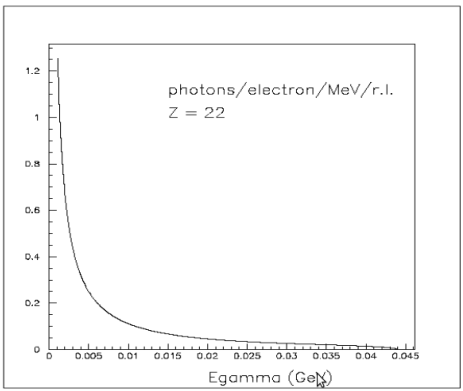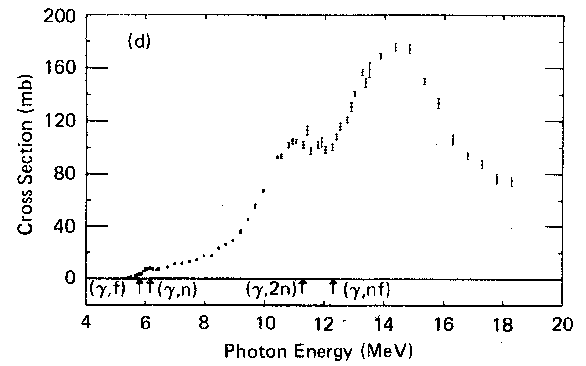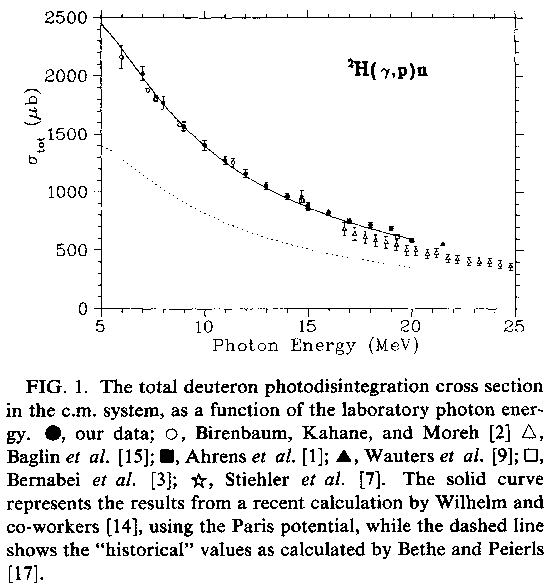Difference between revisions of "Counts Rate (44 MeV LINAC)"
(→yield) |
|||
| Line 87: | Line 87: | ||
fractional solid angle = <math>\frac{\pi * (1 cm)^{2}}{4 \pi (100cm)^{2}} = \frac{1}{4} \cdot 10^{-4}</math> <= geometrical acceptance | fractional solid angle = <math>\frac{\pi * (1 cm)^{2}}{4 \pi (100cm)^{2}} = \frac{1}{4} \cdot 10^{-4}</math> <= geometrical acceptance | ||
| − | finally | + | finally, the yield is: |
<math>1.2 \cdot 10^{6}\ \frac{neutrons}{sec} \times \frac{1}{4} \cdot 10^{-4} = 30\ \frac{neutrons}{sec} </math><br> | <math>1.2 \cdot 10^{6}\ \frac{neutrons}{sec} \times \frac{1}{4} \cdot 10^{-4} = 30\ \frac{neutrons}{sec} </math><br> | ||
| Line 93: | Line 93: | ||
'''Therefore, this experiment is really doable.'''<br><br> | '''Therefore, this experiment is really doable.'''<br><br> | ||
| − | |||
=Counts Rate for Deuteron= | =Counts Rate for Deuteron= | ||
Revision as of 19:21, 19 May 2010
Counts Rate for U238
LINAC parameters used in calculations
1) pulse width 50 ns
2) pulse current 50 A
3) repetition rate 300 Hz
4) energy 44 MeV
Number of electrons/sec on radiator
Number of photons/sec from radiator
bremsstrahlung
in (10,20) MeV region we have about
0.1 photons/electrons/MeV/r.l
radiation length
r.l.(Ti) = 3.59 cm
radiator thickness = 12.5
steps together...
Collimation factor
Collimation factor is
4-6 % of total # of photons (Alex, GEANT calculation)
then, incident flux on target is
Number of neutrons/sec (yields)
photonuclear cross section for reaction
From the paper "Giant resonance for the actinide nuclei: Photoneutron and photofission cross sections for 235U, 236U, 238U, and 232Th", J. T. Caldwell and E. J. Dowdy, B. L. Berman, R. A. Alvarez, and P. Meyer. Physical Review C, (21), 1215, April 1980:
in (10,20) MeV region the average cross section, say, is:
130 mb
target thickness,
Target thickness = 1 cm:
neutrons per fission
2.4 neutrons/fission
steps together...yeild
Worst Case Isotropic Neutrons
Let's say we have:
radius detector = 1 cm
1 meter away
fractional solid angle = <= geometrical acceptance
finally, the yield is:
Therefore, this experiment is really doable.
Counts Rate for Deuteron
photonuclear cross section for reaction=
From the paper "absolute total cross sections for deuteron photodisintegration between 7 and 19 MeV", A. De Graeva and other. Physical Review C, (45), 860, February 1992:
in (10,20) MeV region the average cross section, say, is:
1000 mb
calibration factor
The only difference from calculations above is cross sections
1000 mb / 130 mb = 7.7
yield
Let's say all other factors is the same =>
the yield is :


